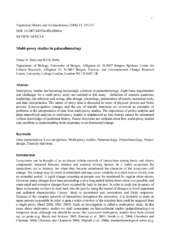| dc.contributor.author | Birks, Hilary H. | eng |
| dc.contributor.author | Birks, Harry John Betteley | eng |
| dc.date.accessioned | 2007-12-05T09:40:08Z | |
| dc.date.available | 2007-12-05T09:40:08Z | |
| dc.date.issued | 2006 | eng |
| dc.Published | Vegetation History and Archaeobotany 2006 15 (4): 235-251 | en |
| dc.identifier.issn | 0939-6314 | en_US |
| dc.identifier.uri | https://hdl.handle.net/1956/2469 | |
| dc.description.abstract | Multi-proxy studies are becoming increasingly common in palaeolimnology. Eight basic requirements and challenges for a multi-proxy study are outlined in this essay – definition of research questions, leadership, site selection and coring, data storage, chronology, presentation of results, numerical tools, and data interpretation. The nature of proxy data is discussed in terms of physical proxies and biotic proxies. Loss-on-ignition changes and the use of transfer functions are reviewed as examples of problems in the interpretation of data from multi-proxy studies. The importance of pollen analysis and plant macrofossil analysis in multi-proxy studies is emphasised as lake history cannot be interpreted without knowledge of catchment history. Future directions are outlined about how multi-proxy studies can contribute to understanding biotic responses to environmental change. | en_US |
| dc.language.iso | eng | eng |
| dc.publisher | Springer | en_US |
| dc.subject | Data interpretation | eng |
| dc.subject | Loss-on-ignition | eng |
| dc.subject | Multi-proxy studies, | eng |
| dc.subject | Palaeoecology | eng |
| dc.subject | Palaeolimnology | eng |
| dc.subject | Project design | eng |
| dc.subject | Transfer functions | eng |
| dc.title | Multi-proxy studies in palaeolimnology | en_US |
| dc.type | Peer reviewed | |
| dc.type | Journal article | |
| dc.identifier.doi | https://doi.org/10.1007/s00334-006-0066-6 | |
| dc.subject.nsi | VDP::Matematikk og Naturvitenskap: 400::Zoologiske og botaniske fag: 480 | nob |
